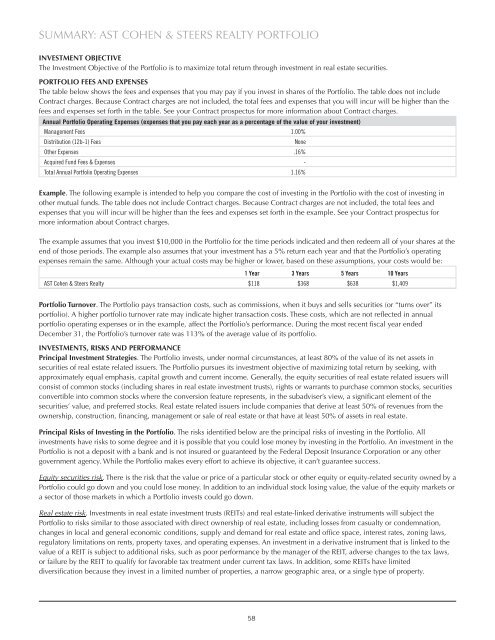Advanced Series Trust AST Academic Strategies Asset ... - Prudential
Advanced Series Trust AST Academic Strategies Asset ... - Prudential
Advanced Series Trust AST Academic Strategies Asset ... - Prudential
Create successful ePaper yourself
Turn your PDF publications into a flip-book with our unique Google optimized e-Paper software.
SUMMARY: <strong>AST</strong> COHEN & STEERS REALTY PORTFOLIO<br />
INVESTMENT OBJECTIVE<br />
The Investment Objective of the Portfolio is to maximize total return through investment in real estate securities.<br />
PORTFOLIO FEES AND EXPENSES<br />
The table below shows the fees and expenses that you may pay if you invest in shares of the Portfolio. The table does not include<br />
Contract charges. Because Contract charges are not included, the total fees and expenses that you will incur will be higher than the<br />
fees and expenses set forth in the table. See your Contract prospectus for more information about Contract charges.<br />
Annual Portfolio Operating Expenses (expenses that you pay each year as a percentage of the value of your investment)<br />
Management Fees 1.00%<br />
Distribution (12b-1) Fees<br />
Other Expenses .16%<br />
Acquired Fund Fees & Expenses -<br />
Total Annual Portfolio Operating Expenses 1.16%<br />
None<br />
Example. The following example is intended to help you compare the cost of investing in the Portfolio with the cost of investing in<br />
other mutual funds. The table does not include Contract charges. Because Contract charges are not included, the total fees and<br />
expenses that you will incur will be higher than the fees and expenses set forth in the example. See your Contract prospectus for<br />
more information about Contract charges.<br />
The example assumes that you invest $10,000 in the Portfolio for the time periods indicated and then redeem all of your shares at the<br />
end of those periods. The example also assumes that your investment has a 5% return each year and that the Portfolio’s operating<br />
expenses remain the same. Although your actual costs may be higher or lower, based on these assumptions, your costs would be:<br />
1 Year 3 Years 5 Years 10 Years<br />
<strong>AST</strong> Cohen & Steers Realty $118 $368 $638 $1,409<br />
Portfolio Turnover. The Portfolio pays transaction costs, such as commissions, when it buys and sells securities (or “turns over” its<br />
portfolio). A higher portfolio turnover rate may indicate higher transaction costs. These costs, which are not reflected in annual<br />
portfolio operating expenses or in the example, affect the Portfolio’s performance. During the most recent fiscal year ended<br />
December 31, the Portfolio’s turnover rate was 113% of the average value of its portfolio.<br />
INVESTMENTS, RISKS AND PERFORMANCE<br />
Principal Investment <strong>Strategies</strong>. The Portfolio invests, under normal circumstances, at least 80% of the value of its net assets in<br />
securities of real estate related issuers. The Portfolio pursues its investment objective of maximizing total return by seeking, with<br />
approximately equal emphasis, capital growth and current income. Generally, the equity securities of real estate related issuers will<br />
consist of common stocks (including shares in real estate investment trusts), rights or warrants to purchase common stocks, securities<br />
convertible into common stocks where the conversion feature represents, in the subadviser’s view, a significant element of the<br />
securities’ value, and preferred stocks. Real estate related issuers include companies that derive at least 50% of revenues from the<br />
ownership, construction, financing, management or sale of real estate or that have at least 50% of assets in real estate.<br />
Principal Risks of Investing in the Portfolio. The risks identified below are the principal risks of investing in the Portfolio. All<br />
investments have risks to some degree and it is possible that you could lose money by investing in the Portfolio. An investment in the<br />
Portfolio is not a deposit with a bank and is not insured or guaranteed by the Federal Deposit Insurance Corporation or any other<br />
government agency. While the Portfolio makes every effort to achieve its objective, it can’t guarantee success.<br />
Equity securities risk. There is the risk that the value or price of a particular stock or other equity or equity-related security owned by a<br />
Portfolio could go down and you could lose money. In addition to an individual stock losing value, the value of the equity markets or<br />
a sector of those markets in which a Portfolio invests could go down.<br />
Real estate risk. Investments in real estate investment trusts (REITs) and real estate-linked derivative instruments will subject the<br />
Portfolio to risks similar to those associated with direct ownership of real estate, including losses from casualty or condemnation,<br />
changes in local and general economic conditions, supply and demand for real estate and office space, interest rates, zoning laws,<br />
regulatory limitations on rents, property taxes, and operating expenses. An investment in a derivative instrument that is linked to the<br />
value of a REIT is subject to additional risks, such as poor performance by the manager of the REIT, adverse changes to the tax laws,<br />
or failure by the REIT to qualify for favorable tax treatment under current tax laws. In addition, some REITs have limited<br />
diversification because they invest in a limited number of properties, a narrow geographic area, or a single type of property.<br />
58

















